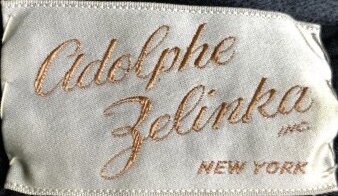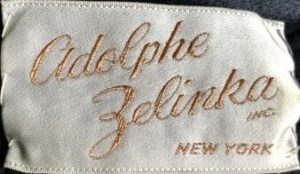Adolphe Zelinka incorporated his company in April 1947 as Miss Petite. It was soon renamed Petite Juniors, and then Zelinka-Rubin. In 1948, it changed names again to Adolphe Zelinka & Co, with the first garment ads using that name appearing that year. He was primarily a coats and suits maker, though he did later make other garments like dresses and blouses. He was the brother of David Zelinka of Zelinka-Matlick (started earlier in 1929), another well-known 7th Avenue coats and suits manufacturer. Originally, located at 242 West 38th Street, by 1957 the company had moved to 512 7th Avenue, 38th Floor, New York.
In November 1957, Saks entered an agreement with designer Anne Fogarty who was employed with them at the time, to furnish her design services to others. Adolphe Zelinka purchased her design services for coats and suits while other manufacturers had agreements for dresses, lingerie, hats, jewelry etc. These agreements lasted until 1962 when she went to establish her own business.
French-born Sony Schotland designed for the company from at least 1964 through 1969. Trained at the École des Beaux Arts in Paris, she had worked with couturier Maggy Rouff and later with Branell in New York before coming to Zelinka. She was the winner of the 1969 American Designers Award, and later designed for Golet.
John Anthony was a designer at the company starting in 1968 and went on to establish his own label in 1971, around the time the company closed. He said he left Zelinka because they wanted him to design ‘matronly’ clothes. During his time with Zelinka, he was strongly influenced by the 1940s as he saw the decade as the best of Jacques Fath and Schiaparelli. A student of Paris couture, he was an outspoken admirer of Givenchy. His work for Zelinka was mainly inspired by pre-Dior 40s, although some of his 1968 collection had some post-1947 midi-lengths.
The company appears to have ceased operation in 1971/72 but wasn’t dissolved until 1982. In early 1973, shortly after the closure, Zelinka went on to become general manager of Originala.
Written by Vintagiality

